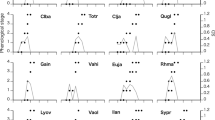Abstract
Leaf growth patterns were investigated in 11 evergreen (with leaf life-spans of just more than 1 year) and 15 deciduous species, occurring along an elevational gradient of 600–2200 m elevation in the Central Himalaya. Records were made of the leaf initiation period, leaf population dynamics, leaf expansion, leaf mass changes, leaf longevity and related parameters. Species of both groups produced leaves at similar rates during March to April, the driest period of the year. Species of both groups had approximately fully developed foliage during the warm, wet period (mid-June to mid-September) of the monsoon. However, significant differences were found at group level in other characters: shoot length (19.5 cm per shoot for deciduous and 11.7 cm for evergreen species); leaf population per 10 cm shoot length (4.7 vs 15.0); leaf area (107.9 vs 41.4 cm2/ leaf); specific leaf mass (106.9 vs 191.3 g/m2); and leaf mass loss after the monsoon period, being rapid and higher (31.6%) in deciduous species and slow and limited in the evergreens (26.2%). However, species of the two groups showed considerable overlaps in the values of above characters. The evergreen species of the Central Himalaya resembled the deciduous species of the region more than the multi-year leaves of clearly evergreen species. The evergreens bear leaves throughout the year, but like deciduous species bear the cost of annual replacement of old leaves by new leaves. They seem to outcompete deciduous species by producing annually a greater mass of leaves of low-carbon cost (per unit leaf mass), which is capable of conducting photosynthesis all year round. A situation of less marked contrast between favourable and nonfavourable periods, with respect to temperature, seems to favour the leaf characters of the evergreens.
Similar content being viewed by others
References
Beard JS (1955) The classification of tropical American vegetation types. Ecology 36:89–100
Boojh R, Ramakrishnan PS (1982) Growth strategy of trees related to successional status. II: Leaf dynamics. For Ecol Managem 4:375–386
Chabot BF, Hicks AJ (1982) The ecology of leaf life-spans. Annu Rev Ecol Syst 13:229–259
Champion HG, Seth SK (1968) A revised survey of the forest types of India. Government of India publication, Manager of Publications New Delhi
Chapin FS, Johnson DA, Mckendrick JD (1980) Seasonal movement of nutrients in plants of differing growth form in an Alaskan tundra ecosystem: implications for herbivory. J Ecol 68:189–210
Chapin FS, Bloom AJ, Field CB, Waring RH (1987) Plant responses to multiple environmental factors. Bioscience 37:49–56
Daalen JCV (1984) Distinguishing features of forest species on nutrient-poor soils in the southern cape. Bothali 15:229–239
Evans GC (1972) The quantitative analysis of plant growth. Blackwell Scientific Publications, Oxford London Edinburgh Melbourne
Givnish TJ (1984) Leaf and canopy adaptations in tropical forests. In: Medina B, Mooney HA, Vasquez-Yanes (eds) Physiological ecology of plants of the wet tropics. Dr. W. Junk, The Hague, pp 51–84
Givnish TJ (1987) Comparative studies of leaf form: assessing the relative roles of selective pressures and phylogenetic constraints. New Phytol 106:131–160
Goldberg De (1982) The distribution of evergreen and deciduous trees relative to soil type: An example from the Sierra Madre, Mexico, and a general model. Ecology 63:942–951
Hall JB, Swaine MD (1981) Distribution and ecology of vascular plants in a tropical rain forest. Dr. W. Junk. The Hague
Khanna RK, Singh SP (1984) Standing state of nutrients. In: Singh JS, Singh SP (eds) An integrated ecological study of Eastern Kumaun Himalaya with emphasis on natural resources, vol II. Final Technical Report (HCS/DST/187/76). Kumaun University, Naini Tal, pp 154–193
Köppen W (1931) Grundriss der Klimakunde, 2nd edn. Bornträger, Berlin
Kozlowski TT (1971) Growth and development of trees, vol I and II. Academic Press, New York
Mooney HA, Rundel PW (1979) Nutrient relations of the evergreen shrubAdenostoma fasciculatum, in the California Chaparral. Bot Gaz 140:109–113
Negi GCS (1989) Phenology and nutrient dynamics of tree leaves in Kumaun Himalayan forests. PhD Thesis, Kumaun University, Naini Tal
Ralhan PK, Khanna RK, Singh SP, Singh JS (1985) Phenological characteristics of the tree layer of Kumaun Himalayan forests. Vegetatio 60:90–101
Sarmiento G (1983) Ecology of neotropical savannas. Harvard University Press, Cambridge, Mass
Singh JS, Singh SP (1987) Forest vegetation of the Himalaya. Bot Rev 52:80–192
Singh SP, Singh RP, Rawat YS (1990) Patterns of soil and vegetation and factors determining their forms and hydrologic cycle in Nanda Devi biosphere reserve. 2nd Annual Report, submitted to Ministry of Environment and Forests. Government of India, New Delhi
Snedecor GW, Cochran WG (1967) Statistical methods. Oxford and IBH Publishing Company, New Delhi
Swank WT, Schrender HT (1974) Comparison of three methods of estimating surface area and biomass for a forest of young eastern white pine. For Sci 20:91–100
Thornthwaite CW (1931) An approach toward a rational classification of climate. Geogr Rev 38:85–94
Valdiya KS (1980) Stratigraphic scheme of the sedimentary units of the Kumaun Lesser Himalaya. In: Valdiya KS, Bhatia SB (eds) Stratigraphy and correlations of the Lesser Himalayan Formations. Hindustan Publication corporation, Delhi, pp 7–48
Walter H (1973) Vegetation of the earth in relation to climate and eco-physiological conditions. Springer-Verlag, New York
Wheat D (1980) Sylleptic branching inMyrine floribunda (Myrsinaceae). Am Bot 67:490–499
Whitmore TC (1975) Tropical rain forests of the Far East. Clarendon Press, Oxford
Wolfe JA (1979) Temperature parameters of humid to mesic forests of eastern Asia and relation to forests of other regions of the Northern Hemisphere and Australasia. US Geological Survey Professional Paper 1106
Author information
Authors and Affiliations
Rights and permissions
About this article
Cite this article
Negi, G.C.S., Singh, S.P. Leaf growth pattern in evergreen and deciduous species of the Central Himalaya, India. Int J Biometeorol 36, 233–242 (1992). https://doi.org/10.1007/BF02726404
Received:
Revised:
Accepted:
Published:
Issue Date:
DOI: https://doi.org/10.1007/BF02726404




